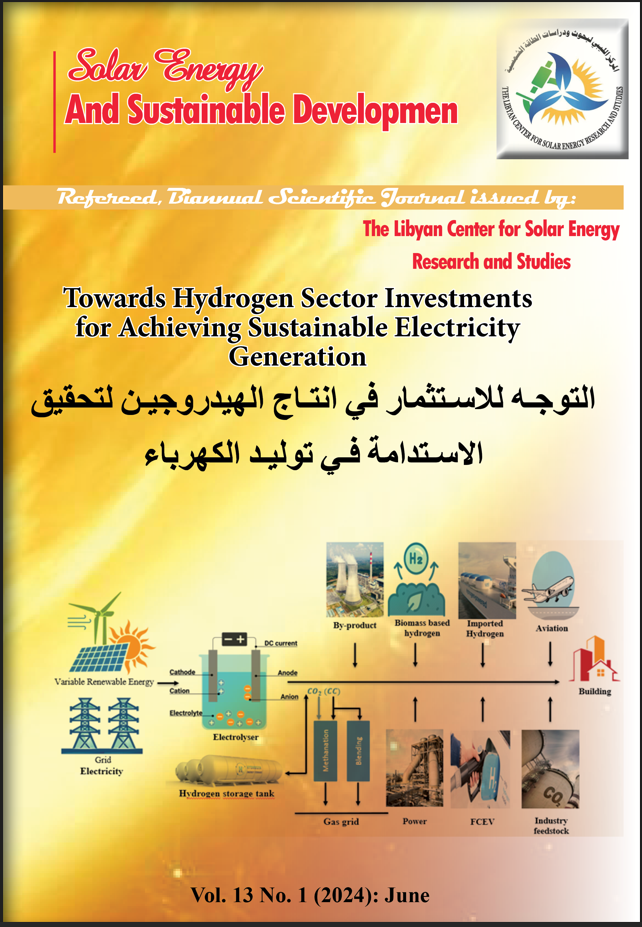Towards Hydrogen Sector Investments for Achieving Sustainable Electricity Generation.
DOI:
https://doi.org/10.51646/jsesd.v13i1.173Keywords:
Hydrogen, Fuel Cell, Integration of renewable energy sources, Electricity generation.Abstract
Hydrogen constitutes an integral component within an expansive array of energy technologies poised to facilitate the nation's transition towards achieving a net-zero state. In additional, this endeavor involves harnessing regional resources judiciously, thereby fostering equitable and sustainable growth. The strategic development and utilization of hydrogen technologies necessitate a nuanced approach, encompassing an assessment of diverse technologies spanning various sectors especially power sector. Such a meticulous strategy aims to forge the most efficacious, cost-effective, and sustainable pathways, underpinned by the discerning adoption of these technologies in the market. The article delves into the intricate relationship between hydrogen and fuel cell technologies, shedding light on their combined impact on the evolving landscape of electricity generation. A particular focus is placed on the integration of variable renewable energy sources, elucidating how hydrogen serves as a key enabler in optimizing the utilization of these fluctuating energy resources. In addition, the article encompasses various methods of hydrogen production, exploring their technological advancements and implications for achieving sustainable electricity generation. Emphasizing the significance of technology development in the hydrogen sector, the paper delves into the potential of hydrogen production methods and their implications for advancing sustainable electricity generation. In essence, the article navigates the trajectory of the hydrogen sector's evolution within the broader context of electricity generation, offering valuable insights into the ongoing developments, challenges, and opportunities. By addressing the critical nexus between hydrogen technologies and the dynamic electricity landscape, the paper aims to contribute to the discourse on the future trajectory of investments in the hydrogen sector for enhanced electricity generation. To Conclude, the United Kingdom has committed GBP 20 billion over a span of 20 years to the development of Carbon Capture, Utilization, and Storage (CCUS) facilities. Additionally, the nation has identified and shortlisted electrolysis projects totalling 408 megawatts (MW) capacity. In Korea, Hanwha Impact has achieved a significant milestone by attaining a 60% hydrogen co-firing share in an 80 MW gas turbine, representing the largest co-firing share recorded thus far in mid-to-large gas turbines. Meanwhile, Anhui Province Energy Group in China has successfully conducted trials involving the co-firing of ammonia at a 300 MW unit. The Group has plans to further extend these trials, aiming to achieve a 50% co-firing level at a 1 GW coal unit. In the United States, notable progress has been made, with a 38% hydrogen co-firing share attained in 2023 at an operational 753 MW combined-cycle power plant.
Downloads
Metrics
References
M. Prévot, et al., “An anthropocene-framed transdisciplinary dialog at the chemistry-energy nexus,” ChemRxiv, 2024. https://doi.org/10.26434/chemrxiv-2024-8px7r. DOI: https://doi.org/10.26434/chemrxiv-2024-8px7r
Z. Abdin, “Bridging the energy future: The role and potential of hydrogen co-firing with natural gas,” J. Clean. Prod., vol. 436, no. 140724, p. 140724, 2024. https://doi.org/10.1016/j.jclepro.2024.140724. DOI: https://doi.org/10.1016/j.jclepro.2024.140724
X. Chen, et al., “Temperature and voltage dynamic control of PEMFC Stack using MPC method,” Energy Rep., vol. 8, pp. 798–808, 2022. https://doi.org/10.1016/j.egyr.2021.11.271. DOI: https://doi.org/10.1016/j.egyr.2021.11.271
Y. Nassar, et al., “Carbon footprint and energy life cycle assessment of wind energy industry in Libya,” Energy Convers. Manag., vol. 300, no. 117846, p. 117846, 2024. https://doi.org/10.1016/j.enconman.2023.117846. DOI: https://doi.org/10.1016/j.enconman.2023.117846
M. Khaleel, Z. Yusupov, A. Ahmed, A. Alsharif, Y. Nassar, and H. El-Khozondar, “Towards sustainable renewable energy,” Appl. Sol. Energy, vol. 59, no. 4, pp. 557–567, 2023. https://doi.org/10.3103/S0003701X23600704. DOI: https://doi.org/10.3103/S0003701X23600704
H. El-Khozondar, et al., "Assessing the Viability of Solar and Wind Energy Technologies in Semi-Arid and Arid Regions: A Case Study of Libya's Climatic Conditions," Applied Solar Energy, vol. 60, no. 1, 2024.
Iea.org. [Online]. Available: https://www.iea.org/reports/global-hydrogen-review-2023. [Accessed: 27-Jan-2024].
Iea.org. [Online]. Available: https://www.iea.org/reports/hydrogen-2156. [Accessed: 27-Jan-2024].
A. Aravindan and P. Kumar, “Hydrogen towards sustainable transition: A review of production, economic, environmental impact and scaling factors,” Results Eng., vol. 20, no. 101456, p. 101456, 2023. https://doi.org/10.1016/j.rineng.2023.101456. DOI: https://doi.org/10.1016/j.rineng.2023.101456
M. Khaleel, et al., “The effect of PEMFC on power grid using advanced equilibrium optimizer and particle swarm optimisation for voltage sag mitigation,” in 2023 IEEE 3rd International Maghreb Meeting of the Conference on Sciences and Techniques of Automatic Control and Computer Engineering (MI-STA), 2023. htt.ps://doi.org/ 10.1109/MI-STA57575.2023.10169228 DOI: https://doi.org/10.1109/MI-STA57575.2023.10169228
L. Engstam, L. Janke, C. Sundberg, and Å. Nordberg, “Grid-supported electrolytic hydrogen production: Cost and climate impact using dynamic emission factors,” Energy Convers. Manag., vol. 293, no. 117458, p. 117458, 2023. https://doi.org/10.1016/j.enconman.2023.117458. DOI: https://doi.org/10.1016/j.enconman.2023.117458
P. Mendrela, W. Stanek, and T. Simla, “Sustainability assessment of hydrogen production based on nuclear energy,” Int. J. Hydrogen Energy, vol. 49, pp. 729–744, 2024. https://doi.org/10.1016/j.ijhydene.2023.07.156. DOI: https://doi.org/10.1016/j.ijhydene.2023.07.156
C. Breyer, G. Lopez, D. Bogdanov, and P. Laaksonen, “The role of electricity-based hydrogen in the emerging power-to-X economy,” Int. J. Hydrogen Energy, vol. 49, pp. 351–359, 2024. https://doi.org/10.1016/j.ijhydene.2023.08.170. DOI: https://doi.org/10.1016/j.ijhydene.2023.08.170
I. Dincer and M. Aydin, “New paradigms in sustainable energy systems with hydrogen,” Energy Convers. Manag., vol. 283, no. 116950, p. 116950, 2023. https://doi.org/10.1016/j.enconman.2023.116950. DOI: https://doi.org/10.1016/j.enconman.2023.116950
Q. Hassan, S. Algburi, A. Sameen, H. Salman, and M. Jaszczur, “Green hydrogen: A pathway to a sustainable energy future,” Int. J. Hydrogen Energy, vol. 50, pp. 310–333, 2024. https://doi.org/10.1016/j.ijhydene.2023.08.321. DOI: https://doi.org/10.1016/j.ijhydene.2023.08.321
N. Kumar and S. Karmakar, “Techno-economic optimization of hydrogen generation through hybrid energy system: A step towards sustainable development,” Int. J. Hydrogen Energy, vol. 55, pp. 400–413, 2024. https://doi.org/10.1016/j.ijhydene.2023.11.272. DOI: https://doi.org/10.1016/j.ijhydene.2023.11.272
L. Zhu, L. Hu, S. Yüksel, H. Dinçer, H. Karakuş, and G. Ubay, “Analysis of strategic directions in sustainable hydrogen investment decisions,” Sustainability, vol. 12, no. 11, p. 4581, 2020. https://doi.org/10.3390/su12114581. DOI: https://doi.org/10.3390/su12114581
P. Vargas-Ferrer, E. Álvarez-Miranda, C. Tenreiro, and F. Jalil-Vega, “Integration of high levels of electrolytic hydrogen production: Impact on power systems planning,” J. Clean. Prod., vol. 409, no. 137110, p. 137110, 2023. https://doi.org/10.1016/j.jclepro.2023.137110. DOI: https://doi.org/10.1016/j.jclepro.2023.137110
G. Kakoulaki, I. Kougias, N. Taylor, F. Dolci, J. Moya, and A. Waldau, “Green hydrogen in Europe – A regional assessment: Substituting existing production with electrolysis powered by renewables,” Energy Convers. Manag., vol. 228, no. 113649, p. 113649, 2021. https://doi.org/10.1016/j.enconman.2020.113649. DOI: https://doi.org/10.1016/j.enconman.2020.113649
R. Felseghi, E. Carcadea, M. Raboaca, C. Trufin, and C. Filote, “Hydrogen fuel cell technology for the sustainable future of stationary applications,” Energies, vol. 12, no. 23, p. 4593, 2019. https://doi.org/10.3390/en12234593. DOI: https://doi.org/10.3390/en12234593
E. Miller, S. Thompson, K. Randolph, Z. Hulvey, N. Rustagi, and S. Satyapal, “US Department of Energy hydrogen and fuel cell technologies perspectives,” MRS Bull., vol. 45, no. 1, pp. 57–64, 2020. DOI: https://doi.org/10.1557/mrs.2019.312
A. Kumar and M. Sehgal, “Hydrogen fuel cell technology for a sustainable future: A review,” in SAE Technical Paper Series, 2018. https://doi.org/10.4271/2018-01-1307. DOI: https://doi.org/10.4271/2018-01-1307
O. Jaramillo, R. Stotts, S. Kelley, and M. Kuby, “Content analysis of interviews with hydrogen fuel cell vehicle drivers in Los Angeles,” Transp. Res. Rec., vol. 2673, no. 9, pp. 377–388, 2019. https://doi.org/10.1177/0361198119845355. DOI: https://doi.org/10.1177/0361198119845355
Q. Hassan, I. D. J. Azzawi, A. Z. Sameen, and H. M. Salman, “Hydrogen fuel cell vehicles: Opportunities and challenges,” Sustainability, vol. 15, no. 15, p. 11501, 2023. https://doi.org/10.3390/su151511501. DOI: https://doi.org/10.3390/su151511501
A. Ambrose, A. Al-Amin, R. Rasiah, R. Saidur, and N. Amin, “Prospects for introducing hydrogen fuel cell vehicles in Malaysia,” Int. J. Hydrogen Energy, vol. 42, no. 14, pp. 9125–9134, 2017. https://doi.org/10.1016/j.ijhydene.2016.05.122. DOI: https://doi.org/10.1016/j.ijhydene.2016.05.122
H. Neef, “International overview of hydrogen and fuel cell research,” Energy (Oxf.), vol. 34, no. 3, pp. 327–333, 2009. https://doi.org/10.1016/j.energy.2008.08.014. DOI: https://doi.org/10.1016/j.energy.2008.08.014
M. Khaleel, et al., “Technical challenges and optimization of superconducting magnetic energy storage in electrical power systems,” e-Prime - Advances in Electrical Engineering, Electronics and Energy, vol. 5, no. 100223, p. 100223, 2023. https://doi.org/10.1016/j.prime.2023.100223.
M. Khaleel, T. Ghandoori, A. Ahmed, A. Alsharif, A. Alnagrat, and A. Abulifa, “Impact of mechanical storage system technologies: A powerful combination to empowered the electrical grids application,” in 2022 IEEE 2nd International Maghreb Meeting of the Conference on Sciences and Techniques of Automatic Control and Computer Engineering (MI-STA), 2022. https://doi.org/10.1109/MI-STA54861.2022.9837670. DOI: https://doi.org/10.1109/MI-STA54861.2022.9837670
M. Moritz, M. Schönfisch, and S. Schulte, “Estimating global production and supply costs for green hydrogen and hydrogen-based green energy commodities,” Int. J. Hydrogen Energy, vol. 48, no. 25, pp. 9139–9154, 2023. https://doi.org/10.1016/j.ijhydene.2022.12.046. DOI: https://doi.org/10.1016/j.ijhydene.2022.12.046
C. Cheng and L. Hughes, “The role for offshore wind power in renewable hydrogen production in Australia,” J. Clean. Prod., vol. 391, no. 136223, p. 136223, 2023. https://doi.org/10.1016/j.jclepro.2023.136223. DOI: https://doi.org/10.1016/j.jclepro.2023.136223
M. Zoback and D. Smit, “Meeting the challenges of large-scale carbon storage and hydrogen production,” Proc. Natl. Acad. Sci. U. S. A., vol. 120, no. 11, 2023. https://doi.org/10.1073/pnas.220239712 DOI: https://doi.org/10.1073/pnas.2202397120
K. Vilbergsson, K. Dillman, N. Emami, E. Ásbjörnsson, J. Heinonen, and D. Finger, “Can remote green hydrogen production play a key role in decarbonizing Europe in the future? A cradle-to-gate LCA of hydrogen production in Austria, Belgium, and Iceland,” Int. J. Hydrogen Energy, vol. 48, no. 46, pp. 17711–17728, 2023. https://doi.org/10.1016/j.ijhydene.2023.01.081. DOI: https://doi.org/10.1016/j.ijhydene.2023.01.081
Iea.org. [Online]. Available: https://www.iea.org/reports/low-emissions-sources-of-electricity. [Accessed: 27-Jan-2024].
Z. Yusupov, et al., “Lessons learned from the Chinese experience in the field of solar photovoltaic energy,” App. Sol. Energy, vol. 60, no. 2, 2024.
I. Imbayah, M. Hasan, H. El-Khozondare, M. Khaleel, A. Alsharif, and A. Ahmed, “Review paper on green hydrogen production, storage, and utilization techniques in Libya,” Sol. Eng. & Sus. Dev. J., vol. 13, no. 1, pp. 1–21, 2024. https://doi.org/10.51646/jsesd.v13i1.165. DOI: https://doi.org/10.51646/jsesd.v13i1.165
A. Davies and A. Hastings, “Lifetime greenhouse gas emissions from offshore hydrogen production,” Energy Rep., vol. 10, pp. 1538–1554, 2023. https://doi.org/10.1016/j.egyr.2023.08.021 DOI: https://doi.org/10.1016/j.egyr.2023.08.021
E. Agyekum, “Is Africa ready for green hydrogen energy takeoff? – A multi-criteria analysis approach to the opportunities and barriers of hydrogen production on the continent,” Int. J. Hydrogen Energy, vol. 49, pp. 219–233, 2024. https://doi.org/10.1016/j.ijhydene.2023.07.229. DOI: https://doi.org/10.1016/j.ijhydene.2023.07.229
A. Bensalem, B. Toual, A. Kouzou, M. Elbar, M. Khaleel, and Z. Belboul, “A framework to quantify battery degradation in residential microgrid operate with maximum self-consumption based energy management system”, SEES, vol. 5, no. 1, pp. 354–370, Feb. 2024. https://doi.org/10.54021/seesv5n1-021. DOI: https://doi.org/10.54021/seesv5n1-021
A. Mio, E. Barbera, A. Massi Pavan, A. Bertucco, and M. Fermeglia, “Sustainability analysis of hydrogen production processes,” Int. J. Hydrogen Energy, vol. 54, pp. 540–553, 2024. https://doi.org/10.1016/j.ijhydene.2023.06.122. DOI: https://doi.org/10.1016/j.ijhydene.2023.06.122
D. Saygin et al., “Ammonia production from clean hydrogen and the implications for global natural gas demand,” Sustainability, vol. 15, no. 2, p. 1623, 2023. https://doi.org/10.3390/su15021623. DOI: https://doi.org/10.3390/su15021623
K. Dillman and J. Heinonen, “Towards a safe hydrogen economy: An absolute climate sustainability assessment of hydrogen production,” Climate, vol. 11, no. 1, p. 25, 2023. https://doi.org/10.3390/cli11010025. DOI: https://doi.org/10.3390/cli11010025
S. Ikonnikova, B. Scanlon, and S. Berdysheva, “A global energy system perspective on hydrogen Trade: A framework for the market color and the size analysis,” Appl. Energy, vol. 330, no. 120267, p. 120267, 2023. https://doi.org/10.1016/j.apenergy.2022.120267. DOI: https://doi.org/10.1016/j.apenergy.2022.120267
F. Qureshi, et al., “A State-of-The-Art Review on the Latest trends in Hydrogen production, storage, and transportation techniques,” Fuel (Lond.), vol. 340, no. 127574, p. 127574, 2023. https://doi.org/10.1016/j.fuel.2023.127574 DOI: https://doi.org/10.1016/j.fuel.2023.127574
M. Khaleel, A. Alsharif, and I. Imbayah, “Renewable energy technologies: Recent advances and future predictions,” AJAPAS, pp. 58–64, 2022. https://aaasjournals.com/index.php/ajapas/article/view/52
T. Wang, et al., “An optimized energy management strategy for fuel cell hybrid power system based on maximum efficiency range identification,” J. Power Sources, vol. 445, no. 227333, p. 227333, 2020. https://doi.org/10.1016/j.jpowsour.2019.227333 DOI: https://doi.org/10.1016/j.jpowsour.2019.227333
T. Pirasaci, “Non-uniform, multi-stack solid oxide fuel cell (SOFC) system design for small system size and high efficiency,” J. Power Sources, vol. 426, pp. 135–142, 2019. https://doi.org/10.1016/j.jpowsour.2019.04.037 DOI: https://doi.org/10.1016/j.jpowsour.2019.04.037
Q. Hassan, A. Sameen, H. Salman, M. Jaszczur, and A. Al-Jiboory, “Hydrogen energy future: Advancements in storage technologies and implications for sustainability,” J. Energy Storage, vol. 72, no. 108404, p. 108404, 2023. https://doi.org/10.1016/j.est.2023.108404 DOI: https://doi.org/10.1016/j.est.2023.108404
J. Miocic, N. Heinemann, K. Edlmann, J. Scafidi, F. Molaei, and J. Alcalde, “Underground hydrogen storage: a review,” Geol. Soc. Spec. Publ., vol. 528, no. 1, pp. 73–86, 2023. https://doi.org/10.1016/j.egyr.2021.12.002 DOI: https://doi.org/10.1144/SP528-2022-88
Q. Hassan, A. Sameen, O. Olapade, M. Alghoul, H. Salman, and M. Jaszczur, “Hydrogen fuel as an important element of the energy storage needs for future smart cities,” Int. J. Hydrogen Energy, vol. 48, no. 78, pp. 30247–30262, 2023. https://doi.org/10.1016/j.ijhydene.2023.03.413 DOI: https://doi.org/10.1016/j.ijhydene.2023.03.413
M. Khaleel, S. Abulifa, I. Abdaldeam, A. Abulifa, M. Amer, and T. Ghandoori, “A current assessment of the renewable energy industry,” AJAPAS, pp. 122–127, 2022. https://aaasjournals.com/index.php/ajapas/article/view/251
R. Karduri and C. Ananth, “Hydrogen economy: Opportunities and challenges for a sustainable future,” SSRN Electron. J., 2023. https://doi.org/ 10.1017/CBO9780511635359 DOI: https://doi.org/10.2139/ssrn.4637769
P. Mendrela, W. Stanek, and T. Simla, “Thermo-ecological cost – System evaluation of energy-ecological efficiency of hydrogen production from renewable and non-renewable energy resources,” Int. J. Hydrogen Energy, vol. 50, pp. 1–14, 2024. https://doi.org/10.1016/j.ijhydene.2023.06.150 DOI: https://doi.org/10.1016/j.ijhydene.2023.06.150
D. Yan, C. Mebrahtu, S. Wang, and R. Palkovits, “Innovative electrochemical strategies for hydrogen production: From electricity input to electricity output,” Angew. Chem. Int. Ed Engl., vol. 62, no. 16, 2023. https://doi.org/10.1002/anie.202214333 DOI: https://doi.org/10.1002/anie.202214333
F. Sgarbossa, S. Arena, O. Tang, and M. Peron, “Renewable hydrogen supply chains: A planning matrix and an agenda for future research,” Int. J. Prod. Econ., vol. 255, no. 108674, p. 108674, 2023. https://doi.org/10.1016/j.ijpe.2022.108674. DOI: https://doi.org/10.1016/j.ijpe.2022.108674
V. Walter, L. Göransson, M. Taljegard, S. Öberg, and M. Odenberger, “Low-cost hydrogen in the future European electricity system – Enabled by flexibility in time and space,” Appl. Energy, vol. 330, no. 120315, p. 120315, 2023. https://doi.org/10.1016/j.apenergy.2022.120315. DOI: https://doi.org/10.1016/j.apenergy.2022.120315
M. Khaleel, M. Adzman, and S. Zali, “An integrated of hydrogen fuel cell to distribution network system: Challenging and opportunity for D-STATCOM,” Energies, vol. 14, no. 21, p. 7073, 2021. https://doi.org/10.3390/en14217073. DOI: https://doi.org/10.3390/en14217073
N. Farrell, “Policy design for green hydrogen,” Renew. Sustain. Energy Rev., vol. 178, no. 113216, p. 113216, 2023. https://doi.org/10.1016/j.rser.2023.113216. DOI: https://doi.org/10.1016/j.rser.2023.113216
M. Khaleel, M. Adzman, S. Zali, M. Graisa, and A. Ahmed, “A review of fuel cell to distribution network interface using D-FACTS: Technical challenges and interconnection trends,” Int. J. Electr. Electron. Eng. Telecommun., vol. 10, no. 5, pp. 319–332, 2021. https://doi.org/10.18178/ijeetc.10.5.319-332. DOI: https://doi.org/10.18178/ijeetc.10.5.319-332
K. Farhana, A. Mahamude, and K. Kadirgama, “Comparing hydrogen fuel cost of production from various sources - a competitive analysis,” Energy Convers. Manag., vol. 302, no. 118088, p. 118088, 2024. https://doi.org/10.1016/j.enconman.2024.118088. DOI: https://doi.org/10.1016/j.enconman.2024.118088
M. Khaleel, Z. Yusupov, A. A. Ahmed, A. Alsharif, A. Alarga, and I. Imbayah, “The effect of digital technologies on energy efficiency policy,” Int. J. Electr. Eng. And Sustain., 1(1), pp. 1–8, 2023. https://ijees.org/index.php/ijees/article/view/5/1.
A. Constantin, “Nuclear hydrogen projects to support clean energy transition: Updates on international initiatives and IAEA activities,” Int. J. Hydrogen Energy, vol. 54, pp. 768–779, 2024. https://doi.org/10.1016/j.ijhydene.2023.09.250 DOI: https://doi.org/10.1016/j.ijhydene.2023.09.250
S. Bolz, J. Thiele, and T. Wendler, “Regional capabilities and hydrogen adoption barriers,” Energy Policy, vol. 185, no. 113934, p. 113934, 2024. https://doi.org/10.1016/j.enpol.2023.113934. DOI: https://doi.org/10.1016/j.enpol.2023.113934
A. Giampieri, J. Ling-Chin, and A. Roskilly, “Techno-economic assessment of offshore wind-to-hydrogen scenarios: A UK case study,” Int. J. Hydrogen Energy, vol. 52, pp. 589–617, 2024. https://doi.org/10.1016/j.ijhydene.2023.01.346. DOI: https://doi.org/10.1016/j.ijhydene.2023.01.346
M. Khaleel, Z. Yusupov, Y. Nassar, H. El-Khozondar, A. Ahmed, and A. Alsharif, “Technical challenges and optimization of superconducting magnetic energy storage in electrical power systems,” e-Prime - Advances in Electrical Engineering, Electronics and Energy, vol. 5, no. 100223, p. 100223, 2023. https://doi.org/10.1016/j.prime.2023.100223 DOI: https://doi.org/10.1016/j.prime.2023.100223
F. Biggins, M. Kataria, D. Roberts, and D. Brown, “Green hydrogen investments: Investigating the option to wait,” Energy (Oxf.), vol. 241, no. 122842, p. 122842, 2022. https://doi.org/10.1016/j.energy.2021.122842. DOI: https://doi.org/10.1016/j.energy.2021.122842
G. Durakovic, P. C. del Granado, and A. Tomasgard, “Powering Europe with North Sea offshore wind: The impact of hydrogen investments on grid infrastructure and power prices,” Energy (Oxf.), vol. 263, no. 125654, p. 125654, 2023. https://doi.org/10.1016/j.energy.2022.125654. DOI: https://doi.org/10.1016/j.energy.2022.125654
D. Lee and K. Kim, “Research and development investment and collaboration framework for the hydrogen economy in South Korea,” Sustainability, vol. 13, no. 19, p. 10686, 2021. https://doi.org/10.3390/su131910686. DOI: https://doi.org/10.3390/su131910686
M. Khaleel, N. El-Naily, H. Alzargi, M. Amer, T. Ghandoori, and A. Abulifa, “Recent progress in synchronization approaches to mitigation voltage sag using HESS D-FACTS,” in 2022 International Conference on Emerging Trends in Engineering and Medical Sciences (ICETEMS), 2022. https://doi.org/10.1109/ICETEMS56252.2022.10093307. DOI: https://doi.org/10.1109/ICETEMS56252.2022.10093307
State.gov. [Online]. Available: https://www.state.gov/report/custom/faba249190/. [Accessed: 27-Jan-2024].
G. He, D. Mallapragada, A. Bose, C. Heuberger-Austin, and E. Gençer, “Sector coupling via hydrogen to lower the cost of energy system decarbonization,” Energy Environ. Sci., vol. 14, no. 9, pp. 4635–4646, 2021. https://doi.org/10.1039/D1EE00627D. DOI: https://doi.org/10.1039/D1EE00627D
A. Alatrash, et al., "Optimum Number of Glass Covers of Thermal Flat Plate Solar Collectors," WAUJPAS, vol. 2, no. 1, pp. 1-10, 2024. https://www.waujpas.com/index.php/journal/article/view/35/19.
A. Alsharif, et al., "Mitigation of Dust Impact on Solar Photovoltaics Performance Considering Libyan Climate Zone: A Review," WAUJPAS, vol. 1, no. 1, pp. 22-27, 2023. https://www.waujpas.com/index.php/journal/article/view/7/6
M. Almihat, and M. Kahn, "Design and implementation of Hybrid Renewable energy (PV/Wind/Diesel/Battery) Microgrids for rural areas," Sol. Eng. & Sus. Dev. J., vol. 12, no. 1, pp. 71-95, 2023. https://jsesd-ojs.csers.ly/ojs/index.php/jsesd/article/view/151/114. DOI: https://doi.org/10.51646/jsesd.v12i1.151
L. Rtemi, W. El-Osta, and A. Attaiep, "Hybrid System Modeling for Renewable Energy Sources," Sol. Eng. & Sus. Dev. J., vol. 12, no. 1, pp. 13-28, 2023. https://jsesd-ojs.csers.ly/ojs/index.php/jsesd/article/view/146/111. DOI: https://doi.org/10.51646/jsesd.v12i1.146
A. Awad, et al., "Energy, economic and environmental feasibility of energy recovery from wastewater treatment plants in mountainous areas: a case study of Gharyan city – Libya," Acta Innovations, vol. 50, no. 4, pp. 46-56, 2023. https://doi.org/10.32933/ActaInnovations.50.5. DOI: https://doi.org/10.32933/ActaInnovations.50.5
M. Salem, et al., "Estimation of CO2 emission factor for the energy industry sector in Libya: a case study," Environment, Development and Sustainability, vol. 23, pp. 13998-14026, 2021. https://doi.org/10.1007/s10668-021-01248-9. DOI: https://doi.org/10.1007/s10668-021-01248-9
A. Makhzom, et al., "Estimation of CO2 emission factor for Power Industry Sector in Libya," The 8th International Engineering Conference on Renewable Energy & Sustainability (ieCRES 2023), 08-09 May 2023, Gaza Strip, Palestine. https://doi.org/10.1109/ieCRES57315.2023.10209528. DOI: https://doi.org/10.1109/ieCRES57315.2023.10209528
A. Makhzom, et al., "Carbon Dioxide Life Cycle Assessment of the Energy Industry Sector in Libya: A Case Study," Int. J. Electr. Eng. & Sustain., vol. 1, no. 3, pp. 145–163, 2023. https://ijees.org/index.php/ijees/article/view/58/30.
M. Abdunnabi, et al., "Energy savings strategy for the residential sector in Libya and its impacts on the global environment and the nation economy," Advances in Building Energy Research, vol. 17, no. 4, pp. 379-411, 2023. https://doi.org/10.1080/17512549.2023.2209094. DOI: https://doi.org/10.1080/17512549.2023.2209094
M. Eteriki, W. El-Osta, N. Yasser, and H. El-Khozondar, "Effect of Implementation of Energy Efficiency in Residential Sector in Libya," The 8th International Engineering Conference on Renewable Energy & Sustainability (ieCRES 2023), 08-09 May 2023, Gaza Strip, Palestine. https://doi.org/10.1109/ieCRES57315.2023.10209521. DOI: https://doi.org/10.1109/ieCRES57315.2023.10209521

Downloads
Published
How to Cite
Issue
Section
License
Copyright (c) 2024 Solar Energy and Sustainable Development Journal

This work is licensed under a Creative Commons Attribution-NonCommercial 4.0 International License.













